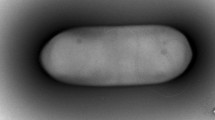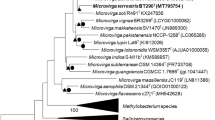Abstract
A bacterial strain, BT25T, was isolated from soil in Korea. The bacterial cells were Gram-negative and rod-shaped. Phylogenetic analysis using 16S rRNA gene sequences showed that the BT25T strain was related to the genus Phyllobacterium. BT25T was 96.6 and 96.5% similar to Phyllobacterium brassicacearum STM 196T and Phyllobacterium myrsinacearum DSM 5892T, respectively. The average nucleotide identity (ANI) and digital DNA-DNA hybridization (dDDH) values between BT25T and the two closest phylogenetic neighbors were calculated to be 78.5 and 77.7, 21.1 and 21.2%, respectively. The major cellular fatty acids were summed feature 8 (C18:1 ω7c/C18:1 ω6c) (29.3%), cyclo-C19:0 ω8c (27.5%), and C16:0 (16.5%). The BT25T strain had menaquinone Q-10 as the predominant quinone, as well as phosphatidylglycerol, phosphatidylethanolamine, phosphatidylmonomethylethanolamine, and phosphatidylcholine as the major polar lipids. Based on the phenotypic, phylogenetic, and chemotaxonomic data, the BT25T strain was classified as a novel Phyllobacterium species. The name Phyllobacterium pellucidum sp. nov. was proposed. The type strain is BT25T (= KCTC 62765T = NBRC 114381T).

Similar content being viewed by others
References
Cappuccino JG, Sherman N (2002) Microbiology: a laboratory manual, 6th edn. Pearson Education, Inc., Benjamin Cummings
Chin C-S, Alexander DH, Marks P, Klammer AA, Drake J, Heiner C, Clum A, Copeland A, Huddleston J, Eichler EE, Turner SW, Korlach J (2013) Nonhybrid, finished microbial genome assemblies from long-read SMRT sequencing data. Nat Methods 10(6):563-569
Doetsch RN (1981) Determinative methods of light microscopy. In: Gerhardt P, Murray RNG, Costitow RN, Nester EW, Wood WA, Krieg NR, Phillips GH (eds) Manual of methods for general bacteriology. American Society for Microbiology, Washington, pp 21–33
Felsenstein J (1981) Evolutionary trees from DNA sequences: a maximum likelihood approach. J Mol Evol 17:368–376
Felsenstein J (1985) Confidence limit on phylogenies: an approach using the bootstrap. Evolution 39:783–791
Fitch WM (1971) Toward defining the course of evolution: minimum change for a specific tree topology. Syst Zool 20:406–416
Flores-Félix JD, Carro L, Velázquez E, Valverde Á, Cerda-Castillo E, García-Fraile P, Rivas R (2013) Phyllobacterium endophyticum sp. nov., isolated from nodules of Phaseolus vulgaris. Int J Syst Evol Microbiol 63:821–826
Hiraishi A, Ueda Y, Ishihara J, Mori T (1996) Comparative lipoquinone analysis of influent sewage and activated sludge by high performance liquid chromatography and photodiode array detection. J Gen Appl Microbiol 42:457–469
Jiao YS, Yan H, Ji ZJ, Liu YH, Sui XH, Zhang XX, Wang ET, Chen WX, Chen WF (2015) Phyllobacterium sophorae sp. nov., a symbiotic bacterium isolated from root nodules of Sophora flavescens. Int J Syst Evol Microbiol 65:399–406
Jurado V, Laiz L, Gonzalez JM, Hernandez-Marine M, Valens M, Saiz-Jimenez C (2005) Phyllobacterium catacumbae sp. nov., a member of the order ‘Rhizobiales’ isolated from Roman catacombs. Int J Syst Evol Microbiol 55:1487–1490
Kimura M (1983) The neutral theory of molecular evolution. Cambridge University Press, Cambridge
Kimura M (1980) A simple method for estimating evolutionary rates of base substitutions through comparative studies of nucleotide sequences. J Mol Evol 16(2):111–120
Knösel DH (1962) Prüfung von Bakterien auf Fähigkeit zur Sternbildung. Zentralbl Bakteriol Parasitenkd Infektionskr Hyg 116:79–100 ((in German))
Komagata K, Suzuki K (1987) Lipid and cell-wall analysis in bacterial systematics. Methods Microbiol 19:161–207
Konstantinidis KT, Tiedje JM (2005) Genomic insights that advance the species definition for prokaryotes. Proc Natl Acad Sci USA 102:2567–2572
Kumar S, Stecher G, Li M, Knyaz C, Tamura K (2018) MEGA X: molecular evolutionary genetics analysis across computing platforms. Mol Biol Evol 35:1547–1549
Lee I, Kim YO, Park CJ (2016) OrthoANI: an improved algorithm and software for calculating average nucleotide identity. Int J Syst Evol Microbiol 66:1100–1103
León-Barrios M, Ramírez-Bahena MH, Igual JM, Peix Á, Velázquez E (2018) Phyllobacterium salinisoli sp. nov., isolated from a Lotus lancerottensis root nodule in saline soil from Lanzarote. Int J Syst Evol Microbiol 68:1085–1089
Mantelin S, Desbrosses G, Larcher M, Tranbarger TJ, Cleyet- Marel JC, Touraine B (2006a) Nitrate-dependent control of root architecture and N nutrition are altered by a plant growth promoting Phyllobacterium sp. Planta 223:591–603
Mantelin S, Saux MF, Zakhia F, Béna G, Bonneau S, Jeder H, de Lajudie P, Cleyet-Marel JC (2006b) Emended description of the genus Phyllobacterium and description of four novel species associated with plant roots: Phyllobacterium bourgognense sp. nov., Phyllobacterium ifriqiyense sp. nov., Phyllobacterium leguminum sp. nov. and Phyllobacterium brassicacearum sp. nov. Int J Syst Evol Microbiol 56:827–839
Meier-Kolthoff JP, Auch AF, Klenk HP, Göker M (2013) Genome sequence–based species delimitation with confidence intervals and improved distance functions. BMC Bioinform 14:60
Mergaert J, Swings J (2015) "Phyllobacterium." Bergey’s Manual of Systematics of Archaea and Bacteria, pp 1–7
Mergaert J, Cnockaert MC, Swings J (2002) Phyllobacterium myrsinacearum (subjective synonym Phyllobacterium rubiacearum) emend. Int J Syst Evol Microbiol 52:1821–1823
Minnikin DE, O’Donnell AG, Goodfellow M, Alderson G, Athalye M, Schaal A, Parlett JH (1984) An integrated procedure for the extraction of bacterial isoprenoid quinones and polar lipids. J Microbiol Methods 2:233–241
Saitou N, Nei M (1987) The neighbor-joining method: a new method for reconstructing phylogenetic trees. Mol Bio Evol 4:406–425
Sasser M (1990) Identification of bacteria by gas chromatography of cellular fatty acids. MIDI Technical Note 101. Newark, DE: MIDI Inc
Stackebrandt E, Ebers J (2006) Taxonomic parameters revisited: tarnished gold standards. Microbiol Today 33:152–155
Tatusova T, DiCuccio M, Badretdin A, Chetvernin V, Nawrocki EP, Zaslavsky L, Lomsadze A, Pruitt KD, Borodovsky M, Ostell J (2016) NCBI prokaryotic genome annotation pipeline. Nucleic Acids Res 44 (14):6614-6624
Weisburg WG, Barns SM, Pellerier DA, Lane DJ (1991) 16S ribosomal DNA amplification for phylogenetic study. J Bacteriol 173:697–703
Acknowledgements
This work was supported by a research grant from Seoul Women’s University (2021) and by a grant from the National Institute of Biological Resources (NIBR), funded by the Ministry of Environment (MOE) of the Republic of Korea (NIBR201902203).
We are grateful to Dr. Aharon Oren (The Hebrew University of Jerusalem, Israel) for helping with the etymology.
Author information
Authors and Affiliations
Contributions
All authors equally contributed to this work.
Corresponding authors
Ethics declarations
Conflict of interest
All authors certify that there is no conflict of interest.
Additional information
Communicated by Erko Stackebrandt.
Publisher's Note
Springer Nature remains neutral with regard to jurisdictional claims in published maps and institutional affiliations.
Supplementary Information
Below is the link to the electronic supplementary material.
Rights and permissions
About this article
Cite this article
Park, Y., Ten, L.N., Maeng, S. et al. Phyllobacterium pellucidum sp. nov., isolated from soil. Arch Microbiol 203, 2647–2652 (2021). https://doi.org/10.1007/s00203-021-02205-w
Received:
Revised:
Accepted:
Published:
Issue Date:
DOI: https://doi.org/10.1007/s00203-021-02205-w




